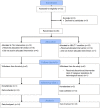A digital health home intervention for people within the Alzheimer's disease continuum: results from the Ability-TelerehABILITation pilot randomized controlled trial
- PMID: 36929703
- PMCID: PMC10030155
- DOI: 10.1080/07853890.2023.2185672
A digital health home intervention for people within the Alzheimer's disease continuum: results from the Ability-TelerehABILITation pilot randomized controlled trial
Abstract
Purpose: This study tested the efficacy of digital-health home intervention for people within the Alzheimer's disease (AD)-continuum.
Methods: Thirty people within the AD continuum were randomly assigned to a telerehabilitation (ABILITY; 6 males, Mage=78.2 ± 3.95) or treatment as usual (TAU; 8 males, Mage=77.13 ± 6.38), performing cognitive and physical activities at home for six weeks. The ABILITY intervention additionally included a digital platform enabling communication between the hospital and the patient's home. Efficiency, such as adherence, perceived fit of demands and skills, usability, and effectiveness measures, including neuropsychological level, neuropsychiatric symptoms, and autonomy in daily living, were collected before (T0), after the treatment (T1), and at the 1-year-follow-up (T2).
Results: The ABILITY program was efficient, with a higher adherence (81% vs. 62%), a higher perceived fit of demands and skills than TAU (p<.05), and a good level of technology usability. In terms of effectiveness, a treatment effect (ABILITY > TAU) emerged on the global cognitive level, especially in language, executive functions, and memory domains. Moreover, a treatment carry-over effect (1-year follow-up) was observed in global cognitive functions (especially language) (ABILITY > TAU), behavioral symptoms, and caregiver distress (TAU > ABILITY).
Conclusions: Our preliminary findings suggest that ABILITY is a promising eHealth intervention to improve at-home treatment adherence and to preserve cognitive and behavioral abilities.
Keywords: Alzheimer’s disease; Dementia; Disability; Mild Cognitive Impairment; Rehabilitation; Telerehabilitation.
Plain language summary
People in the Alzheimer’s Disease continuum facing chronic cognitive disabilities represent an emergency for the healthcare system given the substantial need for long-term rehabilitation;This study evaluates a new model of rehabilitation in the continuity of care for people with cognitive disabilities, adopting an asynchronous approach;The asynchronous telerehabilitation model may be considered a new frontier for continuity of care, capable of answering the unmet need of scaling up rehabilitation services to the broad population.
Conflict of interest statement
No potential conflict of interest was reported by the author(s).
Figures
References
-
- World Health Organization . Global action plan on the public health response to dementia 2017–2025. 2017; Geneva, Switzerland.
-
- Fillit H, Green A.. Aducanumab and the FDA - where are we now? Nat Rev Neurol. 2021;17(3):129–130. - PubMed
-
- Rai H, Yates L, Orrell M.. Cognitive stimulation therapy for dementia. Clin Geriatr Med. 2018;34(4):653–665. - PubMed
-
- Baglio F, Griffanti L, Saibene FL, et al. . Multistimulation group therapy in alzheimer’s disease promotes changes in brain functioning. Neurorehabil Neural Repair. 2015;29(1):13–24. - PubMed
Publication types
MeSH terms
LinkOut - more resources
Full Text Sources
Other Literature Sources
Medical


